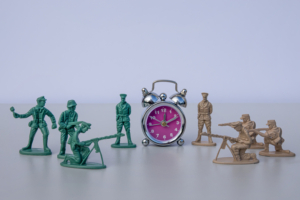Go to Page Section:
- What Is Military Time?
- 1. Clarity and Elimination of Confusion
- 2. Greater Precision in Scheduling
- 3. Professional Use Cases That Influence Daily Life
- 4. Easier Digital Timekeeping
- 5. Improved Time Management and Planning
- 6. Easy to Learn, Universal to Use
- 7. Enhanced Communication in Global Teams
- 8. A Subtle Way to Boost Professionalism
- Final Thoughts

In a world where schedules are tighter and timing is everything, even a small misunderstanding can lead to missed meetings, late arrivals, or costly mistakes.
This is where military time—also known as the 24-hour clock—proves its worth.
While the 12-hour clock is more commonly used in casual conversation, especially in the United States, military time is widely adopted in professional and international settings for its clarity and precision.
But what if this system could make your everyday life easier too?
In this article, we’ll explore the key advantages of military time, how it improves scheduling, reduces ambiguity, and why more people are adopting it beyond the battlefield and into the boardroom.
What Is Military Time?
Military time is a 24-hour timekeeping format that runs from 0000 (midnight) to 2359 (11:59 PM).
Unlike the 12-hour clock, there’s no need to distinguish between AM and PM—each hour of the day is uniquely represented.
For example:
- 8:00 AM = 0800
- 1:00 PM = 1300
- 9:45 PM = 2145
Simple, consistent, and unambiguous.
1. Clarity and Elimination of Confusion
One of the biggest advantages of military time is that it removes confusion between morning and evening hours.
In the 12-hour system, we have to rely on AM and PM to tell us whether a time like “7:00” happens in the morning or at night.
But what happens if someone forgets to include AM or PM?
Or if you misread it?
That small mistake can lead to missed meetings, late arrivals, or even serious problems in professional settings.
Military time gets rid of that problem by assigning a unique number to every hour of the day.
You never have to wonder what someone means when they say “1700”—it always means 5:00 PM, no question.
Let’s look at a few examples:
| Standard Time | AM or PM? | Military Time | Clear? |
|---|---|---|---|
| 7:00 | Could be AM or PM | 0700 or 1900 | ✔ Yes |
| 10:30 | AM or PM? | 1030 or 2230 | ✔ Yes |
| 12:00 | Noon or midnight? | 1200 or 0000 | ✔ Yes |
In the 12-hour format, times like 12:00 can be especially tricky.
Is it noon or midnight?
If you write 0000 in military time, it always means midnight, and 1200 always means noon—no confusion.
This clarity is especially useful:
- When setting alarms (so you don’t accidentally set 7 PM instead of 7 AM)
- When coordinating with others (especially across time zones)
- When scheduling transportation, like buses, trains, or flights
- In medical emergencies where timing is critical
Even in everyday life, using the 24-hour clock means less second-guessing and fewer mistakes.
It’s a small change that brings a big improvement in communication and reliability.
2. Greater Precision in Scheduling
When coordinating across time zones or working in industries where timing matters, precision is everything.
Military time ensures that:
- Trains and flights don’t depart at “the wrong 6:30”
- Doctors and nurses administer medication at the exact right hour
- Emergency responders know exactly when incidents occurred
Even in everyday life, using military time can sharpen your scheduling and minimize the chances of human error.
Whether you’re booking appointments, logging work hours, or creating reminders, the 24-hour clock provides consistency that the 12-hour format lacks.
3. Professional Use Cases That Influence Daily Life
Military time is used every day in many important jobs where accuracy matters.
In fields like healthcare, air travel, and emergency response, even a small time mistake can have serious consequences.
That’s why professionals in these industries rely on the 24-hour clock to keep schedules clear and communication precise.
Because military time is so dependable, it often influences the way people outside these jobs organize their time, too.
Whether you’re booking a doctor’s appointment, catching a flight, or reading a timestamp on a report, you’ve probably come across military time without even realizing it.
Learning to understand and use it in your own life can make time management easier and help you avoid common scheduling errors.
4. Easier Digital Timekeeping
Your smartphone, smartwatch, and computer already support military time—some default to it depending on the region.
Many productivity apps and scheduling tools also allow you to switch between 12-hour and 24-hour modes.
Why not make the switch?
Displaying time in the 24-hour format reduces scrolling through AM/PM menus and offers a sleek, modern alternative.
If you’re unsure how to convert, you can always use a military time converter tool to quickly switch formats until you’re confident reading and using it yourself.
5. Improved Time Management and Planning
Using military time encourages better time awareness.
Because the hours count from 0 to 23, your brain starts visualizing the day as a complete 24-hour cycle.
This leads to:
- Better understanding of how much time remains in your day
- More efficient planning of activities
- More mindful division between morning, afternoon, and evening tasks
Instead of thinking “I’ll do it sometime tonight,” you might start saying “I’ll finish it by 2100.”
That subtle shift can create more accountability and focus in your daily routine.
6. Easy to Learn, Universal to Use
One of the common misconceptions is that military time is “too complicated.”
In reality, it’s just a different way of counting hours:
- From 0000 to 1159, everything is the same as AM time (just with leading zeros).
- From 1200 to 2359, you add 12 to the hour to get the equivalent PM time.
With a bit of practice—or help from a military time converter—you’ll quickly become fluent.
Plus, military time is used around the world, especially in Europe, Asia, and international travel.
Learning it adds a global skill to your toolbox.
7. Enhanced Communication in Global Teams
Remote work and global collaboration have become the norm.
When working across time zones, use military time:
- Prevents cross-time-zone confusion
- Aligns with international standards
- Allows for easier planning of virtual meetings
Telling your colleague in London to meet at 1600 instead of “4 PM your time” makes everyone’s life simpler.
8. A Subtle Way to Boost Professionalism
Small habits—like using military time in schedules, emails, or planning tools—can subtly increase how organized and professional you appear to others.
It signals:
- Attention to detail
- Precision
- Familiarity with international standards
For those in industries like tech, travel, logistics, or medicine, this small change can leave a big impression.
Final Thoughts
Military time may have originated in armed forces operations, but its benefits go far beyond the battlefield.
From minimizing confusion to enhancing productivity, the 24-hour clock format offers a more reliable and globally accepted way to manage time.
Whether you’re coordinating with global colleagues, planning your day with more structure, or just tired of AM/PM mix-ups, switching to military time might be the simplest productivity upgrade you haven’t tried yet.
So next time you look at your watch and see “1600,” don’t panic—you’re on the path to mastering a better way of telling time.
And if you’re ever unsure, a quick check with a military time converter will keep you on track.


Leave Your Comment